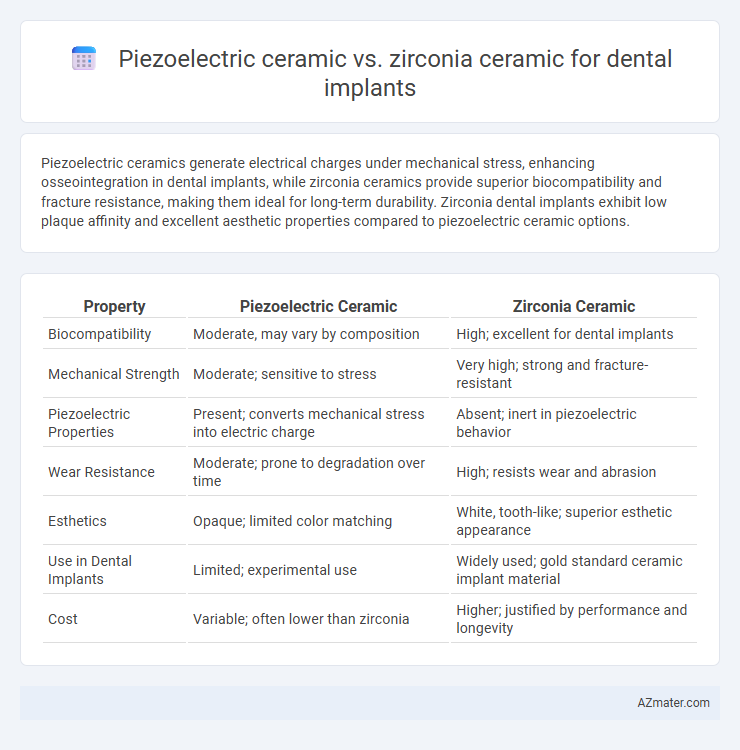Piezoelectric ceramics generate electrical charges under mechanical stress, enhancing osseointegration in dental implants, while zirconia ceramics provide superior biocompatibility and fracture resistance, making them ideal for long-term durability. Zirconia dental implants exhibit low plaque affinity and excellent aesthetic properties compared to piezoelectric ceramic options.
Table of Comparison
| Property | Piezoelectric Ceramic | Zirconia Ceramic |
|---|---|---|
| Biocompatibility | Moderate, may vary by composition | High; excellent for dental implants |
| Mechanical Strength | Moderate; sensitive to stress | Very high; strong and fracture-resistant |
| Piezoelectric Properties | Present; converts mechanical stress into electric charge | Absent; inert in piezoelectric behavior |
| Wear Resistance | Moderate; prone to degradation over time | High; resists wear and abrasion |
| Esthetics | Opaque; limited color matching | White, tooth-like; superior esthetic appearance |
| Use in Dental Implants | Limited; experimental use | Widely used; gold standard ceramic implant material |
| Cost | Variable; often lower than zirconia | Higher; justified by performance and longevity |
Introduction to Dental Implant Materials
Dental implants primarily utilize biocompatible materials such as piezoelectric ceramics and zirconia ceramics, each offering unique properties for osseointegration and durability. Piezoelectric ceramics provide electrical stimulation to enhance bone growth, promoting faster healing around the implant site. Zirconia ceramics, known for their exceptional strength, fracture toughness, and aesthetic white color, offer excellent corrosion resistance and biocompatibility, making them a popular choice for metal-free dental implants.
Overview of Piezoelectric Ceramics
Piezoelectric ceramics, such as lead zirconate titanate (PZT), exhibit the ability to convert mechanical stress into electrical signals and vice versa, making them valuable in dental implant technology for enhancing osseointegration and promoting bone regeneration through electrical stimulation. Unlike zirconia ceramics, which are prized primarily for their high strength, biocompatibility, and aesthetic tooth-like appearance, piezoelectric ceramics offer active biofunctional properties that can improve implant stability and healing outcomes. The integration of piezoelectric ceramics in dental implants is a cutting-edge approach that leverages their electroactive characteristics to accelerate tissue repair and provide real-time monitoring of implant health.
Overview of Zirconia Ceramics
Zirconia ceramics are highly valued in dental implants due to their exceptional biocompatibility, mechanical strength, and aesthetic appeal, closely resembling natural tooth color. Unlike traditional piezoelectric ceramics, zirconia offers superior fracture toughness and resistance to wear, making it ideal for long-term dental applications. Their low thermal conductivity and minimal plaque accumulation further enhance oral tissue compatibility and implant longevity.
Biocompatibility Comparison
Piezoelectric ceramics exhibit moderate biocompatibility with some potential for inflammation due to ion release under mechanical stress, whereas zirconia ceramics demonstrate superior biocompatibility characterized by excellent tissue integration, low plaque affinity, and minimal inflammatory response. Zirconia's inert nature and resistance to corrosion make it highly favorable for dental implants, promoting stable osseointegration and reduced risk of peri-implantitis. In contrast, piezoelectric ceramics may induce localized cellular stress, limiting their widespread use in permanent dental implant applications.
Mechanical Strength and Durability
Piezoelectric ceramics exhibit moderate mechanical strength but excel in responsiveness to mechanical stress, making them less ideal for load-bearing dental implants compared to zirconia ceramics. Zirconia ceramic demonstrates superior mechanical strength and exceptional fracture toughness, providing enhanced durability and longevity in dental implant applications. The high flexural strength of zirconia, typically around 900-1200 MPa, ensures reliable performance under masticatory forces, outperforming piezoelectric ceramics in structural integrity.
Osseointegration Performance
Piezoelectric ceramics exhibit enhanced osseointegration due to their ability to generate electrical signals that stimulate bone cell activity and promote faster bone regeneration around dental implants. Zirconia ceramics offer excellent biocompatibility and mechanical strength but lack the electrical properties that actively enhance bone-implant integration. Studies show piezoelectric materials improve osteoblast proliferation and extracellular matrix formation, leading to superior osseointegration performance compared to inert zirconia ceramics.
Aesthetic Properties in Dental Implants
Piezoelectric ceramics exhibit limited translucency and color stability, making them less suitable for achieving optimal aesthetic outcomes in dental implants compared to zirconia ceramics. Zirconia ceramics offer superior whiteness, translucency, and resistance to staining, closely mimicking natural tooth enamel for enhanced visual appeal. These aesthetic properties of zirconia significantly contribute to patient satisfaction by providing a more natural and lifelike appearance in dental restorations.
Clinical Application and Case Studies
Piezoelectric ceramics demonstrate enhanced osseointegration properties and improved bone healing in dental implants, supported by case studies showing faster recovery times and increased implant stability. Zirconia ceramics, renowned for their biocompatibility and aesthetic appeal, exhibit excellent long-term durability with minimal peri-implant inflammation, as evidenced by clinical trials comparing success rates in anterior and posterior implant sites. Comparative studies highlight piezoelectric ceramics' potential in promoting bone regeneration, while zirconia remains preferred for patients with metal sensitivities and high aesthetic demands.
Cost and Availability Considerations
Piezoelectric ceramics for dental implants are generally less common and more expensive due to their specialized functional properties and complex manufacturing processes. Zirconia ceramics offer a cost-effective and widely available alternative, favored for their biocompatibility and mechanical strength at a lower price point. The broader market availability of zirconia reduces lead times and supports scalability in dental implant production compared to the niche supply chain of piezoelectric ceramics.
Future Trends in Dental Implant Ceramics
Piezoelectric ceramics are gaining attention for dental implants due to their ability to convert mechanical stress into electrical signals, promoting bone regeneration and improving osseointegration. Zirconia ceramics remain popular for their exceptional biocompatibility, high fracture toughness, and aesthetic qualities, but future trends emphasize enhancing their surface properties through nanotechnology and bioactive coatings. Emerging hybrid materials combining piezoelectric and zirconia ceramics aim to optimize mechanical strength and biofunctionality, paving the way for next-generation dental implants with improved longevity and patient outcomes.

Infographic: Piezoelectric ceramic vs Zirconia ceramic for Dental implant
 azmater.com
azmater.com